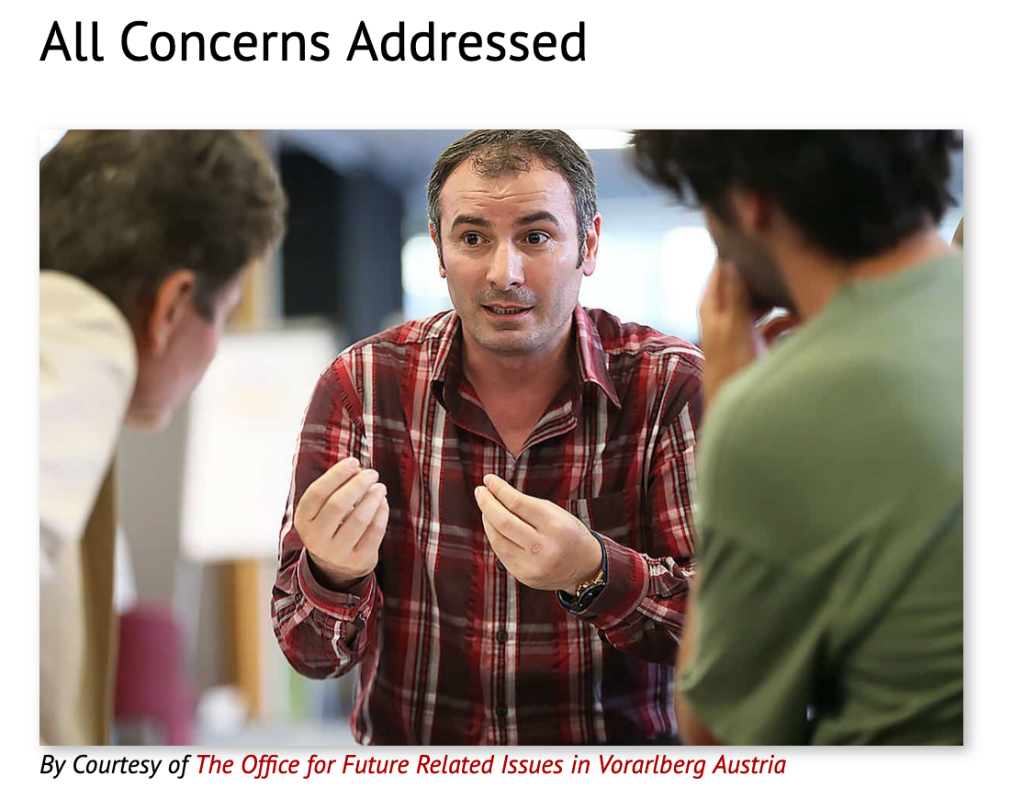
Today I am celebrating Martín Carcasson, awesome professor of communication at Colorado State University and director of the Center for Public Deliberation at CSU. He recently wrote a post on Linked In wondering about the relationship between “openness” and “judgment”… which is what prompted this blog post.
In his post, he writes,
“Democracy needs more than openmindedness. It is an initial key ingredient, but hardly sufficient. If we all assume everyone’s opinion is as good as everyone else’s, how do we make decisions together? How do we distinguish between stronger arguments and weaker ones? What is the role of judgment?”
I am fascinated by this question, and have been wanting to write about it for some time now. “Judgment” can understandably have very negative connotations; no one appreciates being around “judgmental” people. And we know from the field of creativity studies (and experience!) how quickly criticism can shut down creativity. At the same time, it seems to me that we are ALL continuously making judgments… is something helpful or harmful to me? Do I want to pursue this or that course of action? Sometimes in buddhist circles, that is called “discernment” to distinguish it from the less-helpful forms of judgment…
Martín goes on to describe more about the positive value of open-mindedness:
“So in the context of free speech, yes it means we must start completely openminded. No ideas are inherently left out and censored. Everyone has the right to say what they want, even if it is factually wrong or harmful to others. That is necessary, I believe, because it is really hard to draw the line to say some things should be allowed and others not. The unintended consequences of censorship are too much. To honor the necessary fallibilism and intellectual humility tied to a free society, we do need open inquiry as an initial feature.”
In my academic essay on “Relational Epistemologies for a Living Planet“, I explore Peter Elbow’s work on ‘The Believing Game’ and ‘The Doubting Game’. Elbow created the term ‘the believing game’ for attempting to understand a person by “stepping into their shoes” rather than arguing against them, and sees it as a key element in the work of good listening. Given how central good listening is to the art of group facilitation, I see it as extremely relevant in that context as well. However, while Elbow sees both ‘games’ as necessary for a well-rounded and wholistic way of arriving at shared truths, he feels strongly (and I agree with him) that ‘the believing game’, has been undervalued in our culture. And so Elbow does not write very much about the transition between the two, which is what Martín is pointing to here:
“But to leave it there leaves out way too much for me. Another huge aspect of universities is the pursuit of truth/knowledge, which brings in things like excellence, rigor, and the hard work of discriminating between strong arguments and quality information and weak arguments and bs. I want my inquiry initially open (everything goes into the initial funnel), but then we need mechanisms to make sense of all the noise and discriminate/judge quality.”

In the realm of facilitation, different approaches work in different ways to create this balance between openness and discerment/evaluation/judgment. I’ve written elsewhere about how the brainstorming process is designed to separate creative idea generation and critical idea evaluation in time; similarly, the brilliant Six Thinking Hats model1 does this by specifying different times for “green hat thinking” and “yellow hat thinking,” as distinct from “black hat thinking.” In contrast,
“in both Dialogue Mapping and Dynamic Facilitation the facilitator protects participants’ creativity in space. In Dynamic Facilitation, we ask the participant to direct their concerns about an idea to the facilitator, who writes it on the concerns chart. In Dialogue Mapping, the concern is placed on the growing logic tree of the electronic shared display, visibly supplementing (rather than supplanting) the idea that provoked the concern. In both approaches, the spatial redirection serves to minimize interpersonal anxiety, while maximizing creative tension” (Zubizarreta, 2013; emphasis added). 2
In sum, there are multiple ways of ensuring BOTH openness and discernment, within a structured group process. And yes, both are necessary. Even in a Council Circle process, where it may seem that we are not engaging in “discernment” at all as there is no formal “discernment phase” — we are just going round and round in a circle, and there is no one in the role of dynamic facilitator or dialogue mapper — there is still a dynamic spiral that happens, one which is informed by both openness and discernment.
We are in fact, NOT just “going round and round”; people are listening to one another. And so as each person takes a turn speaking, and as each contribution is heard, the simple discipline of waiting until it is one’s turn to speak, gives people a chance to spontaneously reflect on and consider what each person before them has said. As complex adaptive organisms, we humans can’t help but take in, weigh, compare and contrast, and synthesize all of the input we are receiving from the world around us… and have that input inform our judgment. (Which is why social psychologists have studied the behavior of physically “covering one’s ears” when we don’t want to hear someone else speak; it turns out that simply hearing another person’s position, will tend to modify our own.)
On rare occasions, as in Tom Atlee’s story about how a circle process was used by an activist peace camp in a fertilizer factory. we may have enough time to “talk until there is nothing left but the obvious truth”. As we see in that story from his book “The Tao of Democracy“, a circle process can lead to an emergent consensus, by means of this spontaneous process of ongoing discernment. Yet often we don’t quite have the spaciousness to engage in such a lengthy process, and that’s where structured processes like Dialogue Mapping or Dynamic Facilitation can be quite helpful. Of course, they still take time… yet much less time than what we lose in ongoing unproductive friction, when we avoid facing the differences in our perspectives in a more intentional manner.
Regardless of what form of structure or facilitated process we might choose to use, the larger intention of group facitliation is to help us shift the cultural patterns that can lead us to engage in “argument as battle”, as Lakoff and Johnson so brilliantly described.3 However ingrained epistemic competition may be in our culture, the most effective way to arrive at useful, contingent truths is NOT to play “king of the hill”. And helping us shift conversational norms of domination and power-over, is the heart of facilitation — which is why facilitation is at the heart of communicative/participatory/deliberative democracy.
Coda: Martín Carcasson is a prolific author and scholar, and one of the things I appreciate the most about his work is the Center for Public Deliberation‘s emphasis on training student facilitators. In addition, much of what he writes seems to be inspired by work from the field of Organization Development, which is one of my areas of study and practice.
Thanks so much, Martín, for inspiring me to write this blog post!
References
- De Bono, E. (1992). Serious Creativity: Using the Power of Lateral Thinking to Create New Ideas. New York: Harper Collins. Pp. 77–85 ↩︎
- Zubizarreta, R. (2013). “Co-Creative Dialogue for Meeting Practical Challenges”, OD Practitioner, 45(1): 47-53. ↩︎
- Lakoff, G., & Johnson, M. (1980). Metaphors we live by. University of Chicago Press.↩︎
↩︎

Rosa, You are the best. So appreciate this thoughtful summary which covers a lot of ground, well-rounded. I noticed, with a smile, your reference to “discernment” as a term from Buddhist influence, which is within my experience, AND, when I was in Catholic seminary and spiritual direction, spiritual “discernment” was often spoken of, while perhaps too seldom practiced. Spiritual discernment seems to cross the mystical divide between Eastern panentheism and Western monotheism.
I’m also noticing that I associate the climate crisis with systemic trauma, and unconditional warm regard, love, compassionate communication the antithetical ecotherapy of cooperative co-investment in health and environmental wealth.
Gerald Dillenbeck, gdill52.com
Gerald, so good to hear from you! It’s been a while… thank you for bringing up the use of “discernment” in a Catholic context… yes!!! Love your insight about how “spiritual discernment seems to cross the mystical divide between Eastern panentheism and Western monotheism”…
Have just spent a year as a Democracy Fellow at the Ash Center at HKS, and one of my favorite experiences has been auditing courses over at the Divinity School… would love to connect.